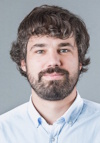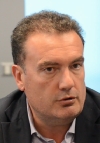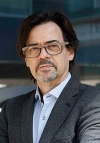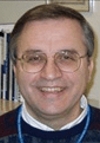Speakers

“Resilient and Reliable Vehicular Communications via Open RAN and Distributed MIMO”
Alister Burr
Univ. of York, UK
Abstract
Open RAN (O-RAN) is a rapidly developing paradigm for the roll-out of wireless networks, already in use for 5G systems and expected to play an important role in 6G. It involves disaggregation and virtualisation of network functions over three main network components: the open Radio Unit (O-RU), Distributed Unit (O-DU) and Centralized Unit (O-CU). Distributed MIMO (D-MIMO), also known as cell-free massive MIMO (CFmMIMO) is a technology – highly compatible with O-RAN – which allows user terminals to be served via multiple access points which are provided by multiple O-RUs. Vehicular communications, especially for autonomous vehicles and other safety-critical applications, is a particularly challenging application for wireless communications, since it requires extremely high reliability under very high mobility conditions, and must also be highly resilient to unexpected changes in the radio environment. The talk will explore how D-MIMO implemented over an O-RAN network can help fulfil these requirements, and what type of network architecture may be most appropriate for this purpose. In particular it will explore how the network functions, especially physical layer functions, might be distributed between these components in this application.
CV
Alister Burr was born in London, U.K, in 1957. He received the BSc degree in Electronic Engineering from the University of Southampton, U.K in 1979 and the PhD from the University of Bristol in 1984. Between 1975 and 1985 he worked at Thorn-EMI Central Research Laboratories in London. In 1985 he joined the Department of Electronics (now part of the School of Physics, Engineering and Technology) at the University of York, U.K, where he has been Professor of Communications since 2000. His research interests are in wireless communication systems, including MIMO and cell-free massive MIMO, Open RAN, physical layer network coding, and iterative detection and decoding techniques. He currently leads the £9.5M project YO-RAN, funded by UK Government. He has published more than 300 papers in refereed international conferences and journals, and is the author of “Modulation and Coding for Wireless Communications” (published by Prentice-Hall/PHEI), and co-author of “Wireless Physical-Layer Network Coding (Cambridge University Press, 2018). In 1999 he was awarded a Senior Research Fellowship by the U.K. Royal Society, and in 2002 he received the J. Langham Thompson Premium from the Institution of Electrical Engineers. He has also given more than 20 invited presentations, including six keynote presentations. He has been co-chair, working group 2, of a series of European COST programmes including currently CA20120 INTERACT, and has also served as Associate Editor for IEEE Communications Letters, Workshops Chair for IEEE ICC 2016, and TPC co-chair for PIMRC 2018 and 2020.

“6G vehicular communications – a physical layer perspective”
Ana Garcia Armada
Univ. Carlos III de Madrid, ES
Abstract
With the emergence of autonomous and electric vehicles, vehicular communications are gaining an important momentum as their fundamental enablers. The conditions that this type of environments impose to communications, particularly the high mobility, create challenges that have not ben solved by the generations prior to 6G. The evolution of mobile communications is expected to enable such new applications and services, not only with focus on communications but including positioning and sensing capabilities as well, which will require a new radio interface. This talk focuses on the new possibilities that are being discussed from a physical layer perspective, presenting alternatives that can cope with this high mobility regarding the waveform design, the channel estimation and prediction, and the way users and reference signals are multiplexed and resources allocated.
Experience now being acquired by the speaker in several collaborative research projects will be shared, namely, projects regarding remote driving and the application of AI to wireless communications. The remote driving application will be the basis for a discussion of the required KPIs, while the use of AI will help improve the communication and positioning capabilities of traditional OFDM and new multi-carrier waveforms, such as OTFS, CE-OFDM, FM-OFDM. The scenarios in which each of them is recommended will be reviewed and, given that there is no one-size-fits-all solution, a flexible physical layer design will be advocated, which is enabled by the multi-carrier nature of most of the proposals making use of a common architecture.
CV
Ana Garcia Armada is an IEEE Fellow. She is currently a Professor at Universidad Carlos III de Madrid, Spain, where she has served in a variety of management positions (Head of Signal Theory and Communications Department, Vice-dean of Electrical Engineering, Deputy Vice-Chancellor of International Relations). She is leading the Communications Research Group at this university. She has been a visiting scholar at Stanford University, Bell Labs and University of Southampton. She has participated and coordinated a large number of national and international research projects as well as contracts with the industry. She is the co-author of eight book chapters on wireless communications and signal processing. She has published more than 250 papers in international journals and conference proceedings and she holds six granted patents. She is serving on the editorial board of IEEE Open Journal of the Communications Society (Associate Editor in Chief since 2024) and ITU Journal on Future and Evolving Technologies. She is the Chair of the IEEE ComSoc Signal Processing and Computing for Communications technical committee and the Vice President of Member and Global Activities of IEEE ComSoc. She has been awarded the third place Bell Labs Prize for shaping the future of information and communications technology. She has received the outstanding service award from the IEEE ComSoc Signal Processing and Communications Electronics technical committee, the outstanding service award from the IEEE ComSoc Women in Communications Engineering Standing Committee, and the IEEE ComSoc/KICS Exemplary Global Service award.

“Intelligent UAV Communication Networks”
António Grilo
INESC INOV-Lab, PT
Abstract
The first two decades of the 21st century have witnessed a boom in the Unmanned Aerial Vehicles (UAVs) market, is all sectors of society, including military, security, industrial and commercial. Irrespective of the specific UAV application area and autonomous capabilities, the communication system constitutes a central piece of the Unmanned Aerial System (UAS).
During the past few years, INESC INOV has been carrying out both theoretical and applied R&D in the topic of UAV communications. This talk will present an overview of the main recent and current work.
The use of UAVs as Flying Base Stations (FBS) to provide communication coverage to ground nodes has been one of the main application areas researched at INESC INOV. These FBS networks can complement and enhance the land-based network infrastructure, or to provide localized coverage in isolated areas. One of the main challenges is the mobility of ground devices. This requires the network of FBSs to constantly adapt its topology to provide continuous coverage and the required quality of service. Theoretical research has focused adaptation and optimization of the FBS network topology based on Artificial Intelligence (AI) techniques. Approaches under study consider both centralized and distributed algorithms, representing a trade-off between message complexity, computational complexity, and optimality. Applied research has been carried out in the context of European projects, such as H2020 project FASTER, as well as small scale implementations and tests in the context of M.Sc. and Ph.D. theses.
CV
Prof. António Grilo holds the Ph.D. degree in Electrical and Computer Engineering from IST, where he is currently Associate Professor. Since 1996, he has been working in European Commission (EC) projects related with communication networks. He is currently a Researcher with the Intelligent Communication Networks group of INESC INOV-Lab, in Lisbon. He is the author or the co-author of more than eighty scientific articles on subjects related with communication networks. His current research interests include UxV networks, Internet of Things, edge computing optimization, and applications of Artificial Intelligence in communication systems and networks.

“Precision and Fault Tolerant Requirements of Autonomous Vehicles Ecosystem”
David Lu
David Lu, Vice President (Retired), Network Systems, AT&T, US
Abstract
Technology innovation is moving ultra-fast in the current decade fueled by the advancements of generative AI, nano semiconductors, quantum computing and quantum communication, AI computing power infrastructure (GPU based cloud) and 5G+/6G/WiFi7/Satellite Communications, and vast interests of user applications. However, more and more scientists and engineers, and even politicians now worry about the sustainable growth of such technology enhancements from energy consumption, large data models with privacy protection and data transparency, cybersecurity and fraud detection/elimination, fault tolerant applications with precision required, to human impact in productivity increase and possible destructive outcomes. This talk will focus on the precision and fault tolerant requirements and regulations of the ecosystem driving the advancements of autonomous vehicle and drone initiatives.
CV
David served in various leadership positions at AT&T that resulted in multibillion-dollar savings over the past 35 years. Currently holds 60+ patents and frequently appears as speaker at technical and leadership seminars and conferences throughout the world. Led global R&D organizations of more than 5,000 people at AT&T. Was responsible for the next generation SDN automation platform enabling AT&T’s network virtualization and 5G/Fiber networks. Well respected as an inspirational industry leader in hyper scale software and AI driven platforms with institutional knowledge and world leading expertise achieving best in class quality, reliability, speed, and demonstrable financial/service benefits! Work pioneered many of the world’s first innovations and promoted many distinguished industry leaders and technical talents. Awards received include CIE-USA AAEOY Engineer of the Year Award in 2017 and Executive of the Year Award in 2023, IEEE CQR Chairman’s Award, CIO 100 Award, AT&T Innovation and Patent Awards, and AT&T Corporate Leadership Award. Actively engaged in community, professional, and faith work.

“The Crucial Role of Spectrum Availability for Reliable 6G Communications”
Doriana Guiducci
European Communication Office of CEPT, DK
Abstract
The Conference of Postal and Telecommunications Administrations (CEPT), through its Committees and in cooperation with the European Telecommunication Standardisation Institute (ETSI) and the European Commission, develops common policies to harmonize the use of radio spectrum, satellite orbits, and numbering resources across Europe. These efforts are crucial for the development of new communication systems, including 6G. The CEPT roadmap for 6G outlines the main strategic phases, from research to commercial launch, and identifies actions for Europe to boost the development of 6G communications.
Vehicular networks in Europe are encompassed within Intelligent Transport Systems (ITS). Regulations in the 5.9 GHz band, where ITS operates, are currently being revised for both safety and non-safety applications to accommodate new use cases. Although regulations are technology-neutral, concurrent technologies wishing to share the frequency band pose challenges that must be considered and effective sharing solutions require full cooperation between spectrum regulators and standardization bodies.
Shared access to spectrum is becoming increasingly crucial, especially for future 6G communications, not limited to vehicular networks. The feasibility of sharing between different technologies and applications is already a hot topic, particularly in the 6 GHz band, where concurrent technologies for connectivity aim to share the band. Various potential approaches and mechanisms for shared spectrum use are currently under investigation, ranging from existing standards to new sharing mechanisms that could be enhanced by advanced techniques such as artificial intelligence.
CV
Dr. DORIANA GUIDUCCI is a spectrum expert at European Communications Office, the permanent office of the European Conference of Postal and Telecommunications Administrations (CEPT), based in Copenhagen (Denmark). Her areas of expertise include mobile broadband, as well as spectrum engineer and frequency regulatory studies on various matters. She is the supporting spectrum expert in several CEPT groups dealing with mobile communications, Radio Local Area Networks and Intelligent Transport Systems. She is also the expert advising the CEPT work on the future use of the 6 GHz band in Europe.
She has been the supporting spectrum expert for CEPT´s preparation and participation in the last two cycles of the World Radiocommunications Conferences (WRC). WRCs are organised by the International Telecommunication Union, the specialised Agency of the United Nations, to revise the Radio Regulations, which is the international treaty governing the use of radio spectrum and orbits at a global level.
She is also responsible within ECO for cooperation and liaison with academia and research bodies and is part of the coordination team of the CEPT Network of Women.
Her previous experience was with Fondazione Ugo Bordoni, the Italian research institution supporting the Public Administration in spectrum matters and ICT policies. She was head of the competence centre on ICT Policies and responsible for several research activities and projects, including pilot experiments for the shared access to spectrum. She completed her master degree and PhD in electronics and computer science at the University of Bologna.

“Edgilty: enhance mobility of future thanks to new connectivities”
Ilhem Fajjari
Orange, FR
Abstract
The coupling of 5G and edge computing is becoming a cornerstone of the ongoing digital revolution, providing advanced capabilities to process data closer to users. Combined with the improvements in bandwidth and latency brought by 5G, this technological paradigm accelerates the adoption of Industry, cloud gaming, and augmented reality. It also paves the way for a new generation of mobility services requiring low latency, high elasticity, and high availability, such as remote automated vehicle control. These use cases demand new capabilities from operator infrastructures to ensure service continuity and maintain optimal performance while on the move. This involves real-time synchronization of distributed application contexts, optimization of user traffic routing, and one-click management of 5G+ and edge services to guarantee elasticity and resilience.
Beyond technological challenges, these advancements address major societal concerns, such as improving quality of life and adopting a more sustainable approach to mobility. By optimizing traffic management and enabling remote vehicle control, cloud-edge and 5G+ contribute to making transportation systems safer, less congested, and more environmentally friendly. The reduction of road congestion aligns with a broader vision that combines technological innovation with a positive impact on urban ecosystems.
CV
Ilhem Fajjari, researcher, senior expert in Orange’s community of experts and project leader for research on cloud-native network function orchestration at
Orange Innovation France. She has also been an associate researcher at the DAVID laboratory of the University of Paris-Saclay since 2020. She earned a Ph.D. in Computer Science, Telecommunications, and Electronics from Sorbonne University in 2012. Her expertise spans Edge Computing, Network Function Virtualization (NFV), 5G, DevSecOps, telco cloud, and Artificial Intelligence. She currently leads a multidisciplinary team specializing in cloud-native network automation and oversee several strategic initiatives for Orange.
Before joining Orange, she was CTO of VirtuOR, a startup innovating in network virtualization.
Her scientific community involvement includes serving as a TPC chair for several international conferences (e.g., IEEE ICC and GLOBECOM) and as a reviewer and author of over 50 articles and several patents. Recognized with awards for her scientific contributions, she is also an active member of “Elles bougent” and Orange’s “Hello Women Role Models” community, promoting women’s roles in technology and innovation.

“PHY Layer Design Strategies Perspective for Resilient Communications in Dense and Sensing-Enabled Radio Networks”
Jan Sykora
Czech Technical Univ. in Prague, CZ
Abstract
Current radio communication networks utilize highly advanced PHY layer coding, modulation and processing technique optimized for throughput, latency and multi-user concurrency. In many aspects, they approach the information-theoretic limits. However, this comes at the price of requiring a highly precise channel state estimation and real-time network/system state knowledge. The channel and network/system state have (especially for M-MIMO systems) a highly dimensional and dynamic signal space representation that typically consumes a large portion of PHY resources (pilot signals, etc.) to enable its precise estimation. The talk will present a framework for various design strategies and trade-offs that needs to be solved in dense and sensing-enabled radio networks with highly dimensional parametric channels.
CV
Jan Sykora is the head of the Digital Radio Communications (DiRaC) group. He obtained an MSc in 1987, a PhD in 1993, and became a Full Professor in 2007, all at the Czech Technical University in Prague. His research includes work on wireless communication and information theory, cooperative and distributed modulation/coding, wireless network coding and distributed signal processing, MIMO systems, non-linear space–time modulation and coding, and iterative processing. He is an author of more than 150 papers in those fields, including a monograph on Wireless Physical Layer Network Coding published by Cambridge University Press 2018.

“Designing and Managing 6G for Reliability”
Jason Rupe
CableLabs, US
Abstract
The use cases that 6G is intended to meet require redesigning the network but reuse of 5G and integration of new technologies. Previous versions of xG have been about communication, but this is shifting as humanity progresses: human communication has morphed into data, compute, and machine. This presents a new paradigm, and a need to examine 6G differently. This includes evolving our way of thinking about reliability. This presentation will discuss the challenges of delivering reliability in 6G networks and present a way to clarify the challenge by presenting a new perspective of reliability. This perspective highlights both specific needs, and opportunities as well.
CV
Jason got his Ph.D. modeling large scale systems and networks for performance and reliability. He has held titles including senior technical staff and director at USWEST, Qwest, Polar Star Consulting, and Tenica. He was the last Managing Editor for the IEEE Transactions on Reliability, Denver Section Chair, and co-chair of IEEE Blockchain initiative. He is currently the President of the IEEE Reliability Society and writes a quarterly column article in Reliability Magazine. At CableLabs, he is the Distinguished Technologist working on Proactive Network Maintenance, Network and Service Reliability, DOCSIS® Tools and Readiness, Optical Operations and Maintenance, and reliability advancement for the industry. He was the RS Engineer of the Year for 2021, and CableLabs inventor of the year for 2020.

“Reliability of Critical Massive IoT Applications in 5G+ Networks: Practical Insights and Lessons Learned from Real Deployments”
Jiri Hosek
Brno Univ. of Technology, CZ
Abstract
With the expanding market and growing interest from both public and private sectors in IoT connectivity, emerging IoT technologies based on established mobile network systems – such as NB-IoT, LTE Cat-M, and 5G NR – have been developed to meet these demands. While expectations, largely shaped by 3GPP standards and theoretical studies, promise significant breakthroughs, the current deployment of cellular systems remains insufficient to meet the demanding requirements of large-scale 5G-IoT implementations. In this talk, we provide an overview of existing 5G-IoT technologies and their real-world capabilities as connectivity enablers for various industrial applications and services, including smart grids. We will discuss key findings and reliability challenges observed during our collaboration with energy distributors and mobile operators in deploying critical massive IoT services.
CV
Jiri Hosek [IEEE Senior Member] received his Ph.D. degree in the field Teleinformatics from the Faculty of Electrical Engineering and Communication at the Brno University of Technology (BUT), Czech Republic, in 2011. He is currently an Associate Professor (2016) and Deputy Head for R&D and International Relations at Department of Telecommunications (2018), BUT. Jiri is also coordinating (2012) the WISLAB research group, where he deals mostly with industry-oriented projects in the area of modern mobile systems, Internet of Things and industrial automation services. Jiri (co-)authored more than 200 research works on networking technologies, wireless communications, quality of service, quality of experience and IoT applications.

“Advancing Battery Reliability and Recycling for Autonomous Vehicles: Emerging Trends and Challenges”
Jun Xu
Univ. Delaware, Newark, US
Abstract
The rapid evolution of autonomous vehicles (AVs) is driving the need for highly reliable and sustainable battery systems that can withstand prolonged operation under dynamic and unpredictable conditions. Unlike conventional electric vehicles, AVs place unique demands on battery performance due to continuous sensor operation, advanced computing requirements, and complex driving patterns, making reliability and longevity paramount. However, the increasing adoption of AVs also raises concerns about battery degradation, failure mechanisms, and the environmental impact of end-of-life disposal.
This talk explores recent trends in battery reliability, focusing on advancements in predictive maintenance, real-time electrochemical diagnostics, and physics-informed machine learning models for state-of-health estimation. We will discuss how innovative battery designs, including solid-state and high-energy-density chemistries, are being tailored to improve safety and durability in AV applications. In addition to reliability, sustainable recycling strategies are critical to minimizing the environmental footprint of large-scale AV battery deployment. The presentation will highlight emerging battery recycling technologies, including direct cathode regeneration, closed-loop material recovery, and second-life applications for retired AV batteries in grid storage and stationary power. Regulatory developments, economic feasibility, and challenges in scaling these recycling approaches will also be examined.
By addressing both the technical and sustainability challenges in battery systems in AVs, this talk aims to provide a comprehensive perspective on enabling a resilient, cost-effective, and circular battery ecosystem for the future of autonomous transportation.
CV
Dr. Jun Xu currently is an Associate Professor (tenured) in the Department of Mechanical Engineering at the University of Delaware (UD), and Director of the Energy Mechanics and Sustainability Laboratory (EMSLab). Dr. Xu is a Fellow at ASME, Senior Member at IEEE, and Member at ECS, AAAS and SAE.
Dr. Xu obtained his Ph.D. from the Department of Earth and Environmental Engineering at Columbia University in 2014 (major in Environmental Engineering and Engineering mechanics).
His research expertise sits in the physics-based and data-driven modeling and characterization of battery safety, durability, design, and manufacturing. Dr. Xu also has expertise in advanced design and understanding of materials and structures upon dynamic loading. So far, Dr. Xu and his students/postdocs have published 150+ peer-reviewed journal papers, with a citation of 9,000+, H-index=53 (Google Scholar).
Dr. Xu enjoys working with highly self-motivated and energetic students, and takes great pride in witnessing their substantial growth and success. Notably, seven of the graduate students he has trained are now tenure-track or tenured professors at reputable universities around the world.

“AI-based Real Time Energy Management using 5G SA”
Kostas G. Vlahodimitropoulos
COO, Local AI, GR
Abstract
Green Energy Transition is a necessary step taken by the European Union (EU) to fight climate change. This transition is imposing new challenges to Power Grids, whose task is to align production and consumption. Production challenges the natural behavior of renewable energy sources such as the sun and the wind. Since these sources have a varying and uncontrollable pattern, they cannot be aligned to that of the consumption. Besides expensive storage, the new trend is to influence the consumption side with a flexible use of electricity pushing its pattern to match the green production one. There is also a European Framework promoting Smart Energy Appliances, appliances that communicate with the Grid regarding the usage patterns.
There is a special need for modeling and forecasting the Charging Station power consumption and the operation of intelligent agents to control the peaks of power coming from the Grid. At big charging stations with many high kW plugs, power peaks can rise to MWs, causing significant stress to the power Grid.
In this paper we focus on the real-time aspect of energy management, which, among other things, yields the need for new high-speed and low latency networks such as 5G-SA. AI is the key enabler of these operations, and in our work, which is funded by the EU Horizon 2020 program TrialsNet, we use Reinforcement Learning, LSTM, RCNN, etc. for precision forecasting power fluctuation in EV Charging Stations. We developed an AI-based intelligent agent tightly integrated with the Charging Point Management System to make on-the-fly decisions for power regulation on charging sessions. We train the agent to forecast dangerous peaks of power consumption on high kW charging stations.
The result is an innovative way of Charging Stations’ power management allowing the future growth of Charging Networks and a positive impact on Green Energy Transition.
CV
Kostas is the COO of Local AI, a tech startup that he founded together with a team of AI experts. Local AI is focused on AI solutions for sustainability projects around Europe. Through AI, it empowers Green Transition initiatives of private and public organizations and has received funding by EU Horizon projects framework.
Kostas has extensive experience in network planning and optimization, having worked for 27 years at Cosmote. He was Deputy Director of Service Quality & Customer Experience Management for Fixed & Mobile. He was involved with several R&D projects including radio resource management, location-based optimization, efficient algorithms for radio propagation, and fleet management. His research interests were in the design and implementation of network-wide big data like for the on-line analytics of network performance vs. customer experience, and interactive presentation techniques using powerful visualization tools.
He received the Computer Engineering Diploma from the Technical University of Patra, Greece, the Master of Science degree in Computer Science from Rutgers University, New Jersey, USA, and Ph.D. in Mobile Telecommunications from the National Technical University of Athens, Greece.

“Perspectives for Improving Quality and Reliability in 6G”
Luís M. Correia
IST / INESC INOV-Lab – Univ. of Lisbon, Lisbon, PT
Abstract
The talk addresses various aspects on the improvement of quality and reliability in communications at the radio interface for incoming 6G systems. Personal and diversity of terminals, impact of MaMIMO and of active antennas, and location accuracy are some of the issues that are analysed.
CV
Luis M. Correia was born in Portugal, in 1958. He received the Ph.D. in Electrical and Computer Engineering from IST (Univ. Lisbon), where he is currently a Professor in Telecommunications, with his work focused on Wireless & Mobile Communications, with the research activities developed in INESC INOV-Lab. He has acted as a consultant for the Portuguese telecommunications operators and regulator, besides other public and private entities, and has been in the Board of Directors of a telecommunications company. He has participated in 34 projects within European frameworks, having coordinated 6 and taken leadership responsibilities at various levels in many others, besides national ones. He has lectured 81 advanced training courses for industry and academia at the national and international levels. He has supervised 240 M.Sc./Ph.D. students, having edited 6 books, contribute to European strategic documents, and authored over 550 papers in international and national journals and conferences, for which served also as a reviewer, editor and board member. Internationally, he was part of 43 Ph.D. juries, and 96 research projects and institutions evaluation committees for funding agencies in 13 countries, and the European Commission and COST. He has been the Chairman of Conference, of the Technical Programme Committee and of the Steering Committee of 25 major conferences, besides other several duties. He was a National Delegate to the COST Domain Committee on ICT. He has launched and served as Chairman of the IEEE Communications Society Portugal Chapter, besides being involved in several other duties in this society at the global level. He is an Honorary Professor of the Gdańsk University of Technology (Poland) and a recipient of the 2021 EurAAP Propagation Award “for leadership in the field of propagation for wireless and mobile communications”.

“Securing the Future of Mobile Technology: Lessons from the Past and Strategies for Tomorrow”
Mikko Karikytö
Chief Product Security Officer & Head of Product Security, Ericsson, SE
Abstract
As society’s digitalization accelerates, driven by advancements in mobile connectivity, AI, and cloud technologies, the cyber threat landscape correspondingly expands. To ensure service continuity, uphold integrity, and maintain user trust, establishing a resilient, secure, and trusted network infrastructure is imperative. Historical trends in telecommunication highlight that similar security oversights are often repeated, leading to significant network vulnerabilities. These gaps are prime targets for attackers seeking valuable assets of the network and its users. Reflecting on these lessons, the future of mobile technology must prioritize adopting modern approaches like Zero Trust Architecture (ZTA) along with advanced AI security measures and quantum resilient encryption. These strategies are vital for effectively mitigating recurring security threats and preparing for future challenges.
CV
Mikko has accountability for security requirements, standards, strategy and architecture, related to product development and management, and overall accountability of product security and product privacy.
He is senior advisor on Product and Solution Security to the CTO, and other executive Ericsson leaders. Mikko has previously worked as Head of Network Security and Head of PSIRT (Product Security Incident Response Team) responding, investigating and solving cyber security incidents and breaches with Ericsson customers globally.
Mikko has also engaged in industry collaboration through organizations like ETIS, FIRST and EU Commission work groups. He has also provided Subject Matter Expertise for committee hearings of the UK parliament and the German Bundestag in 5G Security.

“Building Blocks for 6G Perceptive Networks”
Narcis Cardona
iTEAM Research Institute – Univ. Politècnica de València, ES
Abstract
The 6G enabling technologies are currently being defined, focusing on enhancing network quality, efficiency, and reliability. The research community consistently agrees upon two main pillars when differentiating 6G from the current 5G networks: New networks will be perceptive and AI-driven. The role of AI in these networks is particularly charming, as it will be enriched with real-time data from the sensing capabilities of the network elements. This will allow the AI algorithms to optimize their performance and even to feed Digital Twins of the Radio Access Network, where predictive optimization can run. Modeling and anticipating network conditions in real-time will be critical to guarantee uninterrupted and high-quality connectivity in dynamic environments like those of vehicular communications.
This talk presents the fundamental concepts of Perceptive Networks and how the integration of sensing into RF communications can be a reality in the subsequent releases of 3GPP. The steps ahead after the completion of ISAC sensing towards digital twining are also discussed, as well as their integration into a renewed version of the SDN core stack. The presentation is backed by iTEAM’s research on ISAC channel modeling and Radio Access Digital Twins, which we will reference throughout.
CV
Prof. Cardona has been a founder and the Director of the Research Institute of Telecommunications and Multimedia Applications (iTEAM) of the Universitat Politecnica de Valencia between 2004 and 2025. The iTEAM accounts with 200 researchers, including assistant professors & fellows. At an international scale, Prof. Cardona is currently the director of the 6G Joint Innovation Center and Vice-chair of the One6G Association. During his 35 years of experience, Prof. Cardona has led National and European research projects and Networks of Excellence in FP6, FP7, and H2020, having been the Chairman of COST IC1004, ARCO5G, Vice-Chairman of COST273 and IRACON, P.I. of WAVECOMBE (H2020), and member of the Steering Board of METIS (7FP), WIBEC (H2020), METIS2(H2020), the National Committee CCARS, and partner of the 5G-PPP projects 5G-XCAST, 5G-TOURS, 5G-SMART, 5G-CARMEN, INGENIOUS, FUDGE-5G, 5G-RECORDS. He has been General Chair of the global conferences IEEE ISWCS 2006, IEEE PIMRC 2016, EuCNC 2019, and PIMRC 2024; TPC Chair of IEEE VTC 2015; and organizer of the Global 5G Event in 2019. He has authored 14 patents, over 300 scientific publications, and several international books. Prof Cardona has supervised 27 PhD theses and led 70+ research projects in cooperation with industries. He has been a co-founder and advisor of start-up companies such as Ingenia Telecom, Kenmei Technologies, A4Radar, and Fivecomm, among others, all in the field of mobile and wireless communications.

“Enhancing Security and Resiliency for 6G “
Peter Thermos
President & CTO, Palindrome Technologies, US
Abstract
Currently the standards for 6G are under development in 3GPP which introduces an opportunity to define security requirements and protection mechanisms during the design phase. This talk will review areas (e.g., physical layer security, signaling and user plane security, 6G sensing, HetNets, quantum computing, supply chain) and recommendations that should be taken into consideration as we progress towards ratifying the 6G specifications.
CV
Peter has over 25 plus years of experience in Cyber Security providing consulting to leading commercial organizations and conducting security research for US government organizations (i.e., DARPA, DHS, NIST). As founder of Palindrome Technologies, he is working as a subject matter expert with customers in several industry sectors, including Government, Telecommunication, Financial and Healthcare, in securing Enterprise Networks, Carrier-grade Networks and helping organizations secure emerging technologies including 5G, MEC, IoT, and V2X. Peter is the primary author of the book “Securing VoIP Networks” by Addison-Wesley and has been a speaker at various conferences (i.e., IEEE, ICIW, VoN, SANS, Blackhat, MIS InfoSec, ISSE) and has published research papers in academic and industry journals (i.e., IEEE, ACM, ISSA, IEC) and articles in trade magazines such as Information Security, ZDNET, Forbes, TechTarget and Wired. Furthermore, he has been the Co-Chair for IEEE CQR Workshop, IEEE World Forum IoT and committee member of ICCWS. Furthermore, Peter is a contributor to the FCC CSRIC VII Report on Risk to 5G from Legacy Vulnerabilities and Best Practices for Mitigation (June 10, 2020). Peter holds a Master’s degree in Computer Science from Columbia University, NY, is a senior member of IEEE and ISSA and a member of IETF and ACM.

“Beyond5G: Pioneering the Path to Energy-Efficient 6G Technologies”
Sławomir Stańczak
T.U. Berlin and Fraunhofer HHI, DE
Abstract
Tba
CV
Slawomir Stanczak studied electrical engineering with specialization in control theory at the Wroclaw University of Technology and at the Technical University of Berlin (TU Berlin). He received the Dipl.-Ing. degree in 1998 and the Dr.-Ing. degree (summa cum laude) in electrical engineering in 2003, both from TU Berlin; the Habilitation degree (venialegendi) followed in 2006. Since 2015, he has been a Full Professor for network information theory with TU Berlin and the head of the Wireless Communications and Networks department at Fraunhofer Institute for Telecommunications, Heinrich Hertz Institute (HHI). Prof. Stanczak has been involved in research and development activities in wireless communications since 1997. In 2004 and 2007, he was a Visiting Professor with RWTH Aachen University and in 2008, he was a Visiting Scientist with Stanford University, Stanford, CA, USA. He is a co-author of two books and more than 200 peer-reviewed journal articles and conference papers in the area of information theory, wireless communications, signal processing and machine learning. Prof. Stanczak received research grants from the German Research Foundation and the Best Paper Award from the German Communication Engineering Society in 2014. He was a Co-chair of the 14th International Workshop on Signal Processing Advances in Wireless Communications (SPAWC 2013). Between 2009 and 2011, he was an Associate Editor of the European Transactions for Telecommunications (information theory) and an Associate Editor of the IEEE Transactions on Signal Processing between 2012 – 2015 and the chair of the ITU-T Focus Group on Machine Learning for Future Networks including 5G from 2017 – 2020. Since 2020, Prof. Stanczak is chairman of the 5G BERLIN association and an Editor of the IEEE Journal on Selected Areas in Communications for the special issue “Machine Learning in Communications and Networks”. Since 2021 he is coordinator of the 6G Research & Innovation Cluster and the flagship project CampusOS.

“Emerging Technologies Reliability Roundtable 2025 (ETR-RT25) – Opening Remarks”
Spilios Makris
Technical Chair ETR-RT25; Director, Palindrome Technologies, US
Abstract
ETR-RT25 is an IEEE ComSoc event organized by the Technical Committee on Communications Quality & Reliability (CQR). It was established in 2014. The first ETR-RT was held in Tucson, AZ; this is the 9th year of the event (2020-2022 cancelled due to Covid.
Originally, the scope of the Roundtable was to discuss and identify RAS (Reliability, Availability and Serviceability) challenges, requirements, and methodologies in emerging technology areas. Then, Serviceability and Security were added under the Resilience “umbrella”. Recently, emphasis was given on the huge impact of Artificial Intelligence (AI), with an emphasis on reliability/trustworthiness of AI solutions (Generative AI, Responsible AI, Sustainable AI and AI for Sustainability), and use of Large Language Models (LLMs) to find new/increase coverage of failure models (both security and other failures).
The focus for this year’s Roundtable will be on Vehicular Networks.
CV
Spilios Makris is currently the Director of Network Resilience and Business Continuity Management (BCM) in Palindrome Technologies. Spilios has extensive experience in BCM and network resilience serving as Director and Senior Consultant at Telcordia Technologies (formerly Bellcore) for over 28 years, conducting studies and developing methodologies along with industry Best Practices for over 50 Tier 1&2 telecom companies, telecom vendors, and Telecom Regulatory Authorities (TRAs) worldwide. Spilios has served as Chair, Vice-Chair, Lead Contributor of the Standards T1A1.2 WG on “Network Survivability Performance” (was renamed PRQC Reliability Task Force) for 20 years. He successfully managed the development and regular update of Telcordia Generic Reliability Requirements documents establishing them as the “de facto” industry standards (e.g., SR-332 on Reliability Prediction Procedure for Electronic Equipment). Spilios has served as the Chair of the IEEE Study Group for Security, Reliability, and Performance for Software Defined and Virtualized Ecosystems (e.g., SDN, NFV, etc.).
Spilios received his PhD in Industrial Engineering & Operations Research from the University of Massachusetts at Amherst, Mass., MS in Engineering Management from Northeastern University, Boston, Mass., and Diploma (equiv. to MS) in Electrical & Mechanical Engineering from the National Technical University of Athens, Greece. He is a Certified Business Continuity Professional (CBCP) by the Disaster Recovery Institute International (DRII) and a Senior Member of IEEE.

“Autonomous Cloud Reliability with Agentic AI: A Blueprint or a Pipedream?”
Tianyin Xu
Univ. of Illinois at Urbana-Champaign, US
Abstract
The continuous advances of generative AI and agentic technologies have enabled the aspiration of autonomous cloud reliability, where AI agents promptly and effectively detect, diagnose, and mitigate failures in large-scale production systems to prevent user-facing incidents. How far are we from this grand vision? Is it another AI pipedream or a practical blueprint? What are the unique technical challenges and fundamental research problems? How can we make progress to realize our aspirations?
In this talk, I will share my thoughts on the above questions and my experiences working with my students and colleagues at the IBM-Illinois Discovery Accelerator Institute (https://discoveryacceleratorinstitute.grainger.illinois.edu). Specifically, I hope to demonstrate how to understand some of the questions yourself and how to evaluate AI- or agent-based solutions before putting them in your production.
CV
Tianyin Xu is an Assistant Professor in the Siebel School of Computing and Data Science at the University of Illinois at Urbana-Champaign (UIUC). His research focuses on building reliable and secure computer systems that empower next-generation cloud and datacenter computing. He has been in the UIUC List of Teachers Ranked as Excellent eight times since he joined the CS department in 2018. He received Jay Lepreau Best Paper Awards at OSDI 2024 and 2016, Best Paper Awards at ASPLOS 2020 and 2025, a Best Student Paper Award at SIGCOMM 2021, two SIGSOFT Distinguished Paper Awards at ISSTA 2021 and FSE 2021, a Gilles Muller Best Artifact Award at EuroSys 2023, and a CACM Research Highlight. He is a recipient of a C.W. Gear Outstanding Junior Faculty Award, a Dean’s Award for Excellence in Research, NSF CAREER Award, an Intel Rising Star Faculty Award, and a Facebook Distributed Systems Research award. He is an editor of the SIGOPS Blog and is an area chair of the Journal of Systems Research. More details can be found on his website: https://tianyin.github.io.

“Reliability & Security / AI Era…”
Vladan Pekovič
T-Mobile Czech Republic and Slovak Telekom, CZ
Abstract
Customer needs are rapidly evolving, with seamless connectivity now considered a fundamental human requirement in today’s digital world. The telecommunications industry faces unprecedented pressure to deliver reliable, high-speed, and secure networks as technologies like 5G/6G, AI, and IoT reshape expectations. This transformation introduces significant challenges, including network congestion, increased latency, and escalating cybersecurity threats-many driven by AI advancements. Legacy systems and regulatory complexities further complicate efforts to modernize and automate network infrastructure. To meet these new customer demands, the industry is embracing AI-driven automation, self-healing networks, advanced security solutions, and cloud-native architectures to ensure resilient, responsive, and future-ready connectivity.
CV
Vladan Pekovič, CTIO at T-Mobile Czech Republic and Slovak Telekom, joined the local teams in August 2021, but has been with Deutsche Telekom since 2009. Prior to coming to the Czech Republic and Slovakia, he was CEO at Telekom Romania. From January 1, 2024, he held the position of interim CEO of T-Mobile and Slovak Telekom. In addition to a number of new responsibilities, he is in charge of technology transformation and digitalization, with an emphasis on the expansion of optical and 5G networks.

“Reliability challenges and opportunities for AI infra: from industry perspective”
Chengqiang Huang
Technical Expert of Network Modelling, Huawei, CH
Abstract
AI clusters are emerging as a critical infrastructure and technological frontier. As models grow in size following scaling laws, ensuring stable and reliable operation of large-scale model tasks on massive AI clusters has become a significant challenge in the industry.
Training and inference tasks for large models are highly coupled and low-fault-tolerant systems. Distributed training involves frequent communication between nodes, strong dependencies across parallel domains, and requirements for proper computational accuracy. These factors lead to frequent training interruptions due to hardware failures, slow recovery, and fail-slow. Additionally, silent data corruptions can result in model non-convergence. As the scale of training expands, reliability becomes a major bottleneck.
The key challenge is to build a highly available AI system architecture capable of supporting scenarios such as training on clusters with hundreds of thousands of cards, inference on super-nodes with hundreds or thousands of cards, and integrated training-inference tasks. Achieving “zero” perception of fault recovery in business operations is essential for ensuring the reliability of large model infrastructures. Addressing these challenges will be critical for advancing the scalability and robustness of AI systems in the future.
CV
Dr. Chengqiang Huang is a technical expert in Huawei Technologies Co., Ltd. His primary research interests lie in reliability modeling and analysis of complex systems, especially complex network systems that require ultra-reliability, e.g., 5G core network. For the past years working in Huawei, Chengqiang had also participated in reliability analysis of public cloud systems, distributed data storage systems, AI cluster systems, etc. He holds a Ph.D. degree in network management from the University of Exeter and is now responsible for network reliability in the Reliability Technology Lab in Huawei.

